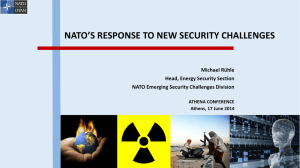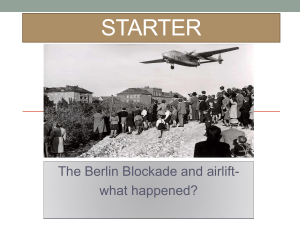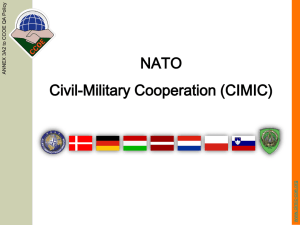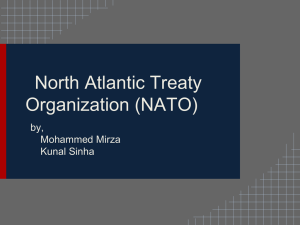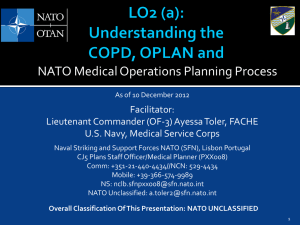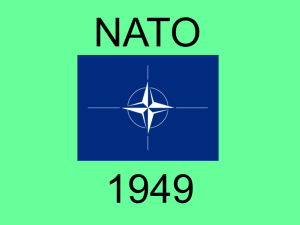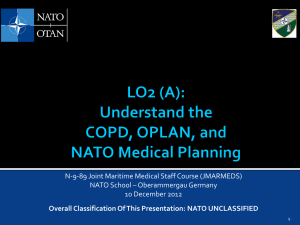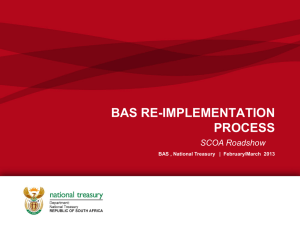Target Audience
advertisement
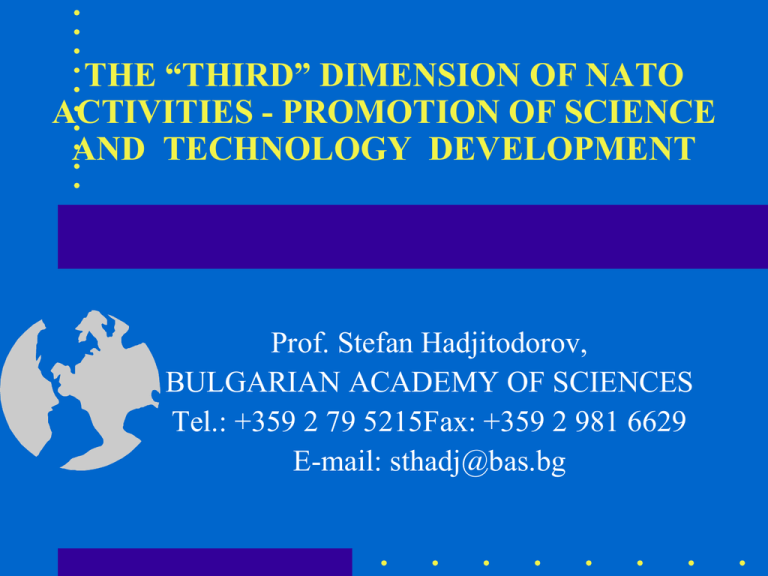
THE “THIRD” DIMENSION OF NATO ACTIVITIES - PROMOTION OF SCIENCE AND TECHNOLOGY DEVELOPMENT Prof. Stefan Hadjitodorov, BULGARIAN ACADEMY OF SCIENCES Tel.: +359 2 79 5215Fax: +359 2 981 6629 E-mail: sthadj@bas.bg NATO Science Program The Science for Peace and Security Programme (SPS) is a policy tool for enhancing cooperation and dialogue with all partners, based on civil science and innovation, to contribute to the Alliance’s core goals and to address the priority areas for dialogue and cooperation identified in the new partnership policy. Science is both a means of finding answers to critical questions and a way of connecting nations. • Founded in 1958, the Programme contributes towards the Alliance’s core goals and promotes regional cooperation through scientific projects and activities. Over its long history, the SPS Programme has continuously adapted to the demands of the times. To this end, a comprehensive reorientation of the Programme took place in 2013, which gave SPS a renewed focus on larger scale strategic activities beyond purely scientific cooperation. • The SPS Programme now promotes civil, security-related practical cooperation, and focuses on a growing range of contemporary security challenges, including terrorism, defence against chemical, biological, radiological, and nuclear (CBRN) agents, cyber defence, energy security and environmental concerns, as well as human and social aspects of security NATO Science Committee One of the most efficient international funding source supporting joint research activities in given scientific priority areas Science for Peace and Security since 2011 PRIORITY AREAS OF SUPPORT • Facilitate mutually beneficial cooperation on issues of common interest, including international efforts to meet emerging security challenges • Enhance support for NATO-led operations and missions • Enhance awareness on security developments including through early warning, with a view to preventing crises • Any project related clearly to a threat to security not otherwise defined in these priorities may also be considered for funding under the SPS Programme. Such proposals will be examined for links to NATO’s Strategic Objectives. Facilitate mutually beneficial cooperation on issues of common interest, including international efforts to meet emerging security challenges – Counter-Terrorism • • • • – Energy Security • • • • – • Critical infrastructure protection, including sharing of best practices, capacity building and policies; Support in developing cyber defence capabilities, including new technologies and support to the construction of information technology infrastructure; Cyber defence situation awareness. Defence against CBRN Agents • • • – Innovative energy solutions for the military; battlefield energy solutions; renewable energy solutions with military applications; Energy infrastructure security; Maritime aspects of energy security; Technological aspects of energy security. Cyber Defence • • – Methods for the protection of critical infrastructure, supplies and personnel; Human factors in the defence against terrorism; Detection technologies against the terrorist threat for explosive devices and other illicit activities; Risk management, best practices and technologies in response to terrorism. Methods and technology regarding the protection against, diagnosing effects, detection, decontamination, destruction, disposal and containment of CBRN agents; Risk management and recovery strategies and technologies; Medical countermeasures against CBRN agents. Environmental Security • • • Security issues arising from key environmental and resource constraints, including health risks, climate change, water scarcity and increasing energy needs, which have the potential to significantly affect NATO’s planning and operations; Disaster forecast and prevention of natural catastrophes; Defence-related environmental issues. Enhance support for NATO-led operations and missions – Provision of civilian support through SPS Key Priorities; – Provision of access to information through internet connectivity as in the SILK-Afghanistan Programme; – Cultural and social aspects in military operations and missions; – Enhancing cooperation with other international actors. Enhance awareness on security developments including through early warning, with a view to preventing crises – Security-related Advanced Technology • Emerging technologies including nanotechnology, optical technology, micro satellites, metallurgy and the development of UAV platforms. – Border and Port Security • Border and port security technology; • Cross border communication systems and data fusion; • Expert advice and assessments of border security needs and best practice. – Mine and Unexploded Ordnance Detection and Clearance • Development and provision of advanced technologies, methodologies and best practice; • Solutions to counter improvised explosive devices (IED). – Human and Social Aspects of Security related to NATO’s strategic objectives Any project related clearly linked to a threat to security not otherwise defined in these priorities may also be considered for funding under the SPS Programme. Such proposals will be examined for links to NATO’s Strategic Objectives. GRANT MECHANISMS The SPS Programme supports collaboration through three established grant mechanisms: • multi-year research & development projects, • research workshops, • training courses. Multi-year R & D projects • What: These are research and development projects related to NATO’s strategic goals and relevant to the SPS Key Priorities. • Duration: typical duration of 3 to 4 years. • Target Audience: Applications are submitted jointly by an expert residing and working in a NATO country and one residing and working in a Partner country. Projects involving more than one Partner country are encouraged, as is the participation of young scientists. • Budget: NATO funds are provided to cover project-related costs such as scientific equipment, computers, software and training of project personnel as well as of young scientists: roughly half of the budget is generally allocated to equipment, about 20% to training and travel and 15% to stipends; these proportions may vary according to the needs of each project Multi-year R & D projects Project Proposal and Project Plan - the first step involves submitting a short project proposal for evaluation by the ISEG. If the project proposal is selected, a planning grant will be awarded in order for the applicants to develop a detailed Project Plan (step two) Advanced Research Workshop (ARW) • What: Advanced-level discussions between qualified experts from different countries with the aim of addressing contemporary security challenges • Duration: 2-5 days • Target Audience: 20-50 participants, with the workshop preferably being held in the Partner country. • Budget: The SPS grant (average amount: 30,000 to 40,000 EUR) is intended to cover direct organizational expenses of the ARW (should not exceed 25% of the NATO grant), the travel and living expenses of key speakers, as well as the attendance of non-speakers from NATO countries and Partner countries unable to obtain support from other sources. Training courses Advanced Study Institutes (ASI) • What: This is a high-level tutorial course offering the latest developments in a NATO-relevant subject to an advanced-level audience. • Duration: An ASI lasts about 7 working days. Lecturers of international standing report new advances on topics of securityrelated civil science. • Target Audience: Post-doctoral level scientists with a relevant background in the subject matter of the course. In particular, young scientists from NATO Partner countries are encouraged to attend. • Budget: The SPS grant (average 60,000 EUR) pays for direct organizational costs, travel and living expenses of up to 15 lecturers and attendance of students (60 to 80) from countries eligible to receive NATO funding. Advanced Training Courses (ATC) • What: This is a course designed to enable specialists in NATO countries to share their security-related expertise in one of the SPS Key Priority areas. An ATC is not intended to be lecture-driven, but to be intensive and interactive in nature. The course contributes to the training of experts in Partner countries and enables the formation and strengthening of international expert networks. • Target Audience: Trainees (20 to 50) primarily from Partner countries. These trainees are chosen on the basis of their qualifications and experience and the benefit they may draw from the ATC in their future activities. • Duration: 5-7 working days • Budget: The SPS grant (average 60,000 EUR) pays for direct organizational costs, travel and living expenses of all specialists and attendance costs of trainees from countries eligible to receive NATO funding. Selection procedure • The deadlines for 2015 are as follows: - 1 March - 1 July - 1 October • Reviewed by the Independent Scientific Evaluation Group (ISEG). • As a decision on funding can take up to 9 months following an application deadline, it is important to take this into consideration when proposing dates for an activity. NATIONAL GRANTS/AWARDS total number -271 Number of Grants Number of Grants 45 40 35 30 25 20 15 10 5 0 39 29 15 9 16 18 29 21 16 10 11 Year 13 10 8 7 7 6 3 2 2 Country distribution - Partner country Number of grants 8 7 7 7 6 6 5 4 3 3 3 3 2 2 1 1 1 1 0 Partner country 1 1 1 1 Science for Peace Projects So far the Bulgarian scientists have been granted 17 Science for Peace Planning Grants and 14 Science for Peace Projects Grants. Research field of SfP projects Number of projects Science for Peace Priority Area 16 14 12 10 8 6 4 2 0 15 9 6 1 ESP CBP Priority area ICS HSD Distribution by co-director’s country Number of Grants Grantee Distribution 180 160 140 120 100 80 60 40 20 0 162 67 42 7 BAS University of Sofia Other institutions Institution/Organization Joint projects BAS/US; BAS/TU Particularly successful projects • High Power and High Efficiency Cooper Bromide Laser for Precision Materials, Institute of Solid State Physics – Bulgarian Academy of Sciences (BAS), University of Bayreuth, Germany and other partners from Italy and Poland; • Dynamics, Evolution and Limitation of Heavy Metals Water Pollution in the Plovdiv Region (Bulgaria), Geological Institute - BAS, and partners from France and Belgium; • High Power and High Frequency Devices, Institute of Applied Physics - BAS, Foundation for Research & Technology, Greece Particularly successful projects • Alternative Approaches of Bioproduction of Alkaloids and Active Substances from Bulgarian Rare and Threatened Medicinal PlantsInstitute of Botany, BAS; Institute of Microbiology, BAS ; Bulgarian pharmaceutical company Sopharma JFCo; Université de Reims Champagne-Ardenne (France);University Paul Sabatier, CNRS, Toulouse (France) • Improving the Reliability of Large Welded Structures by Local Explosive Treatment- Institute of Metal Science, BAS;Technical University of Brauschweig, Brauschweig, Germany • PREPARATION AND PERFORMANCE OF POROUS ELECTRO- & PHOTO-CATALYTIC COATINGS- Institute of Physical Chemistry, BAS; Institute of Catalysis, BAS; Department of General & Inorganic Chemistry, Sofia University, Physical Chemistry Lab, Chemistry Department, Aristotle University of Thessaloniki, Greece ;School of Chemical, Envi-ronmental and Mining Engineering, University of Nottingham, UK; ATARO CLIMA, Plovdiv;CHIMATECH, Sofia; PRESTA ENGINEERING Ltd, Sofia Other data • Panel members After year 2000 six Bulgarian scientists have been members of Science and Technology Policy Panel; Environmental Science and Technology Panel; Human and Societal Dynamics Panel. • Participation in ASI and ARW more than 1250 Bulgarian scientists were included among the participants in ASIs and ARWs (2/3 from BAS). • Financing The projects and activities with Bulgarian participation so far have been funded by more than 8 500 000 Euro CONCLUSIONS • Counting the grants awarded over the period 1993-2008 Bulgaria ranks 6-th place within the Partner countries – after Russia, Ukraine, Poland, Czech Republic and Hungary. About 80 % of the grants awarded are in traditionally strong fields in Bulgarian R&D as information technologies, materials science, life science and agriculture. Personal and institutional contacts established on the base of successful bilateral cooperation and memberships in various international scientific organizations and associations are important prerequisite for developing competitive projects. CONCLUSIONS Bulgarian scientists have the experience and competence to disclose and define properly the important and real economical and environmental problems, which are set as project objectives. Clear project goals are between the most important requirements and prerequisites for funding. The insufficient financial resources for R&D in Bulgaria, the favorable application procedures and the enhanced competence in preparing project proposals, combined with a high number of good proposals have led to an average success rate for the Bulgarian projects of about 12-13% which is higher than the average success rate for the NATO Science Programs as a whole. • Bulgarian scientists are active participants and already effectively integrated into NATO Scientific community. THANK YOU FOR YOR ATTENTION!


